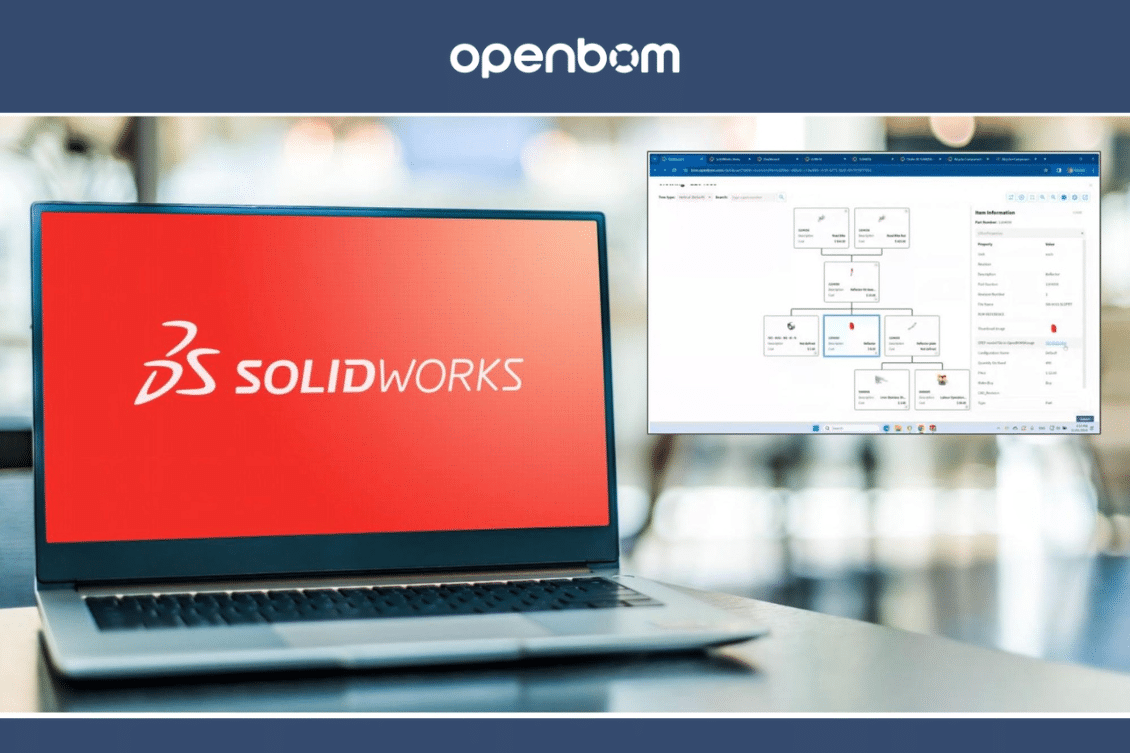
In the world of mechanical design, engineering, product development, and manufacturing, managing full digital records has become increasingly important. The time of folders and files is gone. The wave of digital transformation has ushered in a crucial shift from document-based processes to data-driven methodologies.
However, for engineers who still live in the world of desktop CAD systems like Solidworks, the modern digital transformation process is a challenge. All their world is document-based, files/folders organized and they are desperately looking at how to keep both worlds requirements – preserving a polished and proven Solidworks-based design and product development combined with modern digital connected release process connecting production facilities, online supply chain, contractors and suppliers distributed across the globe.
OpenBOM offers an indispensable tool in this transformative journey. Today, we will explore how OpenBOM can revolutionize your company’s product release process, turning it fully digital in five comprehensive steps.
Digital Process Foundation
The foundation of any digital process is data. OpenBOM provides a flexible data management platform designed to capture a wide array of information – from CAD files and their derivatives to items and Bill of Materials (BOMs). This product knowledge graph of information is synthesized into a Digital BOM, forming the foundation of your company’s digital release process.
This shift is not just about data storage, but about harnessing data for smarter, more efficient workflows and accelerating development processes.
The Five Steps in the Digital Release Process
The Digital Release Process includes multiple steps and involves many people organizing their work together from different locations, different systems, and time zones. Let’s discuss what includes a modern digital process using OpenBOM. Here are 5 steps:
File Capture and Version Baseline:
The first step involves capturing all relevant files and establishing a version baseline. This foundational stage ensures that all subsequent processes are built on a solid, version-controlled base.
OpenBOM allows Solidworks users to seamlessly save all files for their projects in the cloud and organize their file control, prevent multiple people from changing the same file at the same time, and manage project revisions.
Data Capture and Building a Digital BOM
Here, OpenBOM automatically captures data and constructs a digital BOM. OpenBOM’s flexible model and seamless integration with Solidworks allow it to capture all data, configurations, rules, and exceptions.
This includes all relevant product information and derivatives (automatically generating PDF, STEP, DXF, etc), structuring them in an accessible and coherent manner.
Digital BOM Completion and Multi-Disciplinary Integration
At this stage, the digital BOM is refined and completed, integrating inputs from various disciplines if necessary, to ensure a comprehensive and multi-disciplinary product structure including mechanical, electrical, electronic, and software components. The overall product structure is captured in OpenBOM and fully discoverable and integrated.
Revision and Release of an Approved Immutable Digital BOM
This crucial phase involves the revision and release of the digital BOM. OpenBOM automatically captures all changes, preserves revisions, and helps to organize change management processes with people approvals.
The released version is immutable, ensuring the integrity and reliability of the data.
Sharing and Distribution
The final step with OpenBOM is the sharing and distribution of the digital BOM. The platform makes it readily available to all team members, contractors, suppliers, and downstream systems like ERP, ensuring seamless collaboration and communication.
It is very easy also to export data in an old-fashioned PDF format including a zip with all files and share it with CMs and suppliers
Benefits of the Digital Release Process
Digital transformation and digital processes are essential elements of establishing more efficient organizations and processes. Here are the top 3 benefits that any organization can get by establishing digital processes.
- Creation of a Data Foundation with a Single Source of Truth: This process establishes a singular, reliable source for all changes and updates, enhancing consistency and accuracy.
- Time-Saving and Quality Improvement: By streamlining the release process, OpenBOM saves precious time and significantly improves the quality of the output.
- Full Traceability of Product Information: OpenBOM ensures that every piece of product information is traceable, adding layers of accountability and transparency to the process.
I want to bring a story from VarTech Systems, an OpenBOM customer. Read the story – VarTech Systems Optimizes Efficiency by Saving Two Hours of Engineering Time Daily with OpenBOM
“OpenBOM easily saves us 2 hours a day in engineering time. I remember we caught a $1000 mistake the first month we had OpenBOM. Our Excel had not been updated. OpenBOM literally paid for itself that month.”
Conclusion
Solidworks, a system developed 30 years ago, has been a great support for generations of engineers in design. It stands as the de-facto standard in MCAD. However, the demands of digital transformation call for a correction to the document/file-based nature of Solidworks.
OpenBOM offers an easy and scalable solution to transition Solidworks design releases into the digital age. With its state-of-the-art Solidworks integration and robust data management and collaborative platform, OpenBOM paves the way for a more efficient, transparent, and effective product development process.
REGISTER FOR FREE and check how OpenBOM can help you today. Best,
Oleg
Join our newsletter to receive a weekly portion of news, articles, and tips about OpenBOM and our community.










